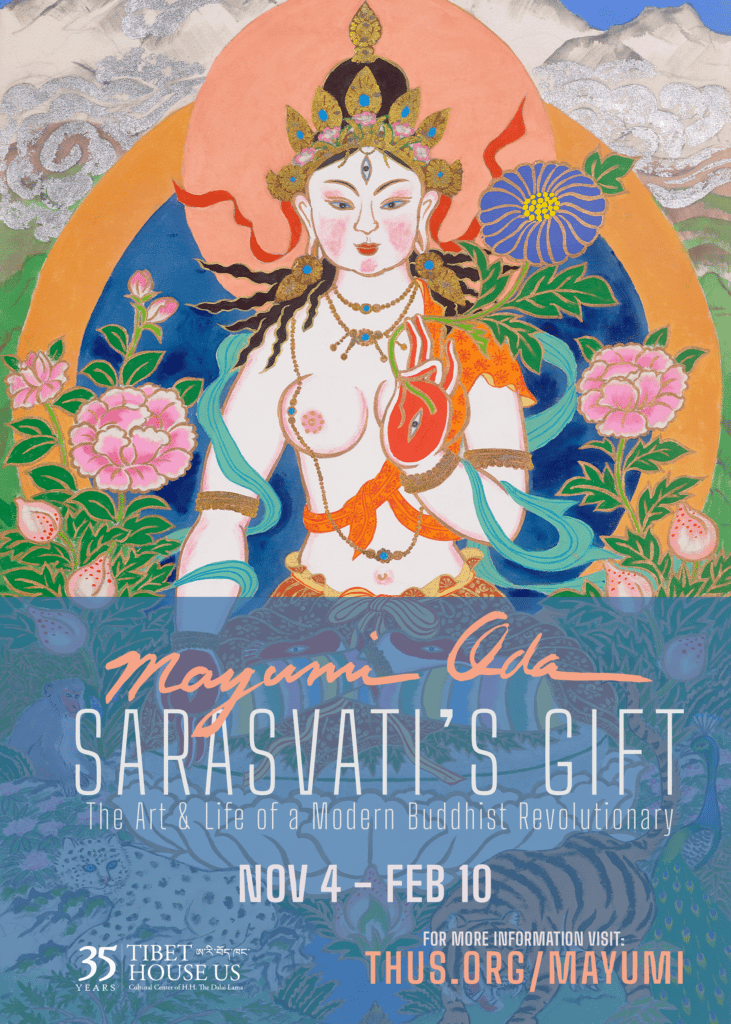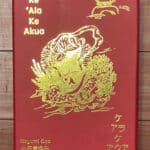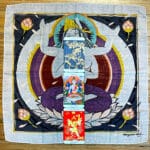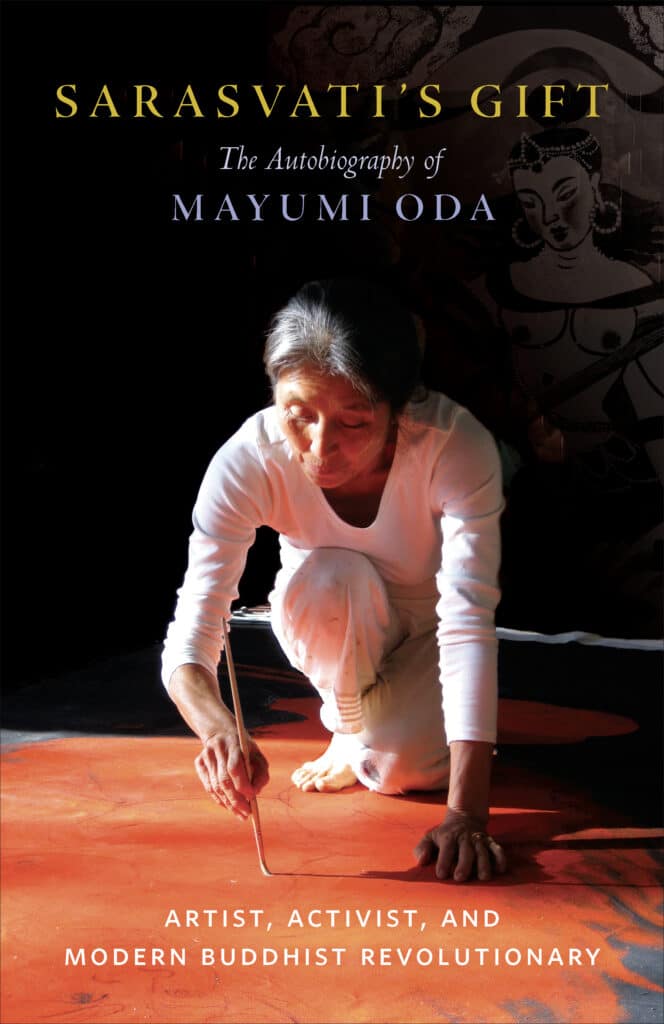
ON VIEW NOV 4 – FEB 10
TIBET HOUSE US GALLERY NYC
Friday, November 4, 2022 | 6-8pm ET
Tibet House US Gallery NYC
22 W 15th St, New York, NY 10011
Join us in-person at Tibet House US Gallery for the opening reception of Sarasvati’s Gift: The Art & Life of a Modern Buddhist Revolutionary, an exhibition of work by renowned artist Mayumi Oda. She will be joined by special guest Robert A.F. Thurman, President of Tibet House.
Known as the “Matisse of Japan,” Mayumi Oda is a painter, environmental activist, and Buddhist practitioner whose life reflects both the brilliance and shadows of modernity. Sarasvati’s Gift explores her tremendous artistic talent and inspiration drawn from her Buddhist practice and her commitment to healing the planet.
“Sarasvati’s Gift, Mayumi Oda’s great gift—how wonderful to receive it in this beautiful, heartfelt, honest book. Sarasvati, the goddess of art, the Lady of the River of Beauty, is the cleansing divine flow of the waters of truth and beauty, and she emanates to heal and cleanse our stressed-out lives on our stricken planet through the undaunted art and golden heart of Mayumi Oda.”
— Robert A.F. Thurman
Signed copies of Sarasvati’s Gift: The Autobiography of Mayumi Oda—Artist, Activist, and Modern Buddhist Revolutionary (Shambhala, 2020) will be available at the event.
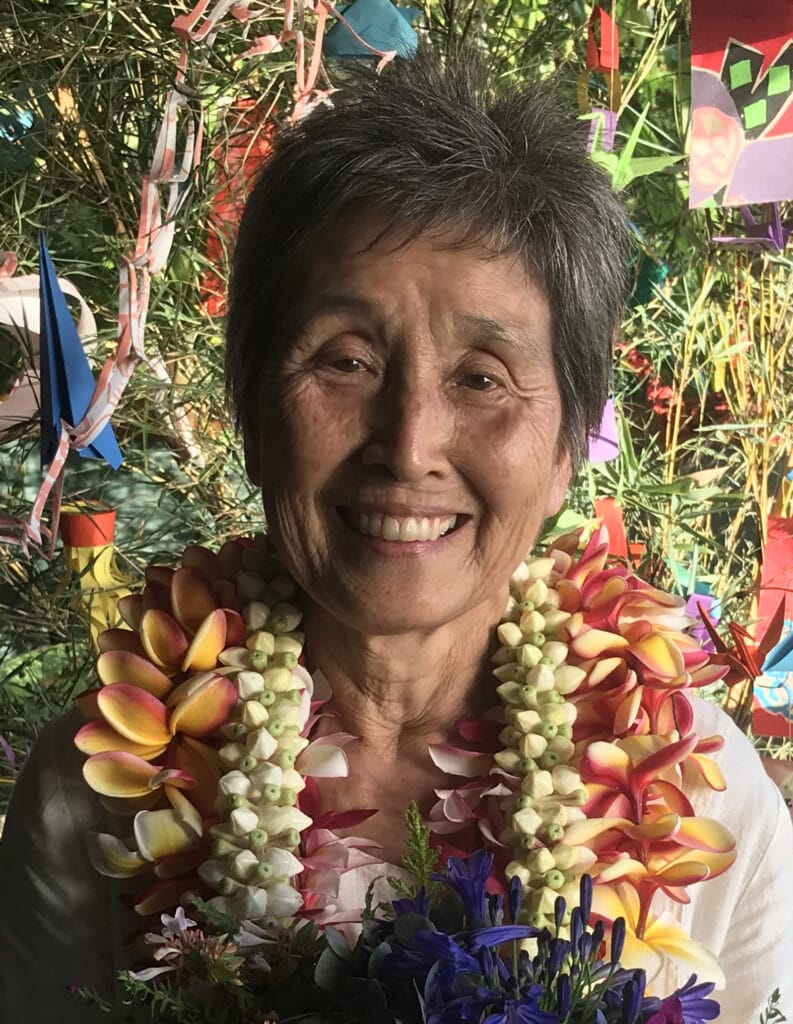
ARTIST BIO

Mayumi Oda’s storied life as an artist began as a small child as her mother sought to bring joyful creativity early in her daughter’s world. That nurturing instilled a desire to make her mother happy and so, becoming an artist was born of mutual love and an innate knowing rather than a conscious decision. Drawing for hours each day for years in school formed a discipline while honing Mayumi’s eyes, hands, and mind to draw anything that she wanted. As a Zen Buddhist, Mayumi’s father also imbued the importance of concentration and being present – things she embraced even more as an adult practicing Zazen meditation. This was the preparation for a prolific and evolving artistic journey in the forthcoming decades.
Intensely spiritual, sensitive, and yet, exceptionally strong-willed for a Japanese woman, Mayumi has always painted authentically, from the heart, never for commercial appeal. As a young woman and emerging artist, Mayumi was highly inspired by female beauty. Painting Goddesses contributed to an inward self-awareness while presenting an outward, positive expression of feminism. During different periods as a woman, wife, and mother, painting served as an escape, awakening, or expression when life presented challenges and opportunities. As her art received greater attention, travel, and exposure to more people and influences have ensued for many years leading to diverse subjects, styles, and collections comprising several hundred paintings. She has come to be known as the “Matisse of Japan”.
From 1969 to the present, Mayumi has presented multitudinous solo and group shows internationally and has numerous private and permanent collections at the Museum of Modern Art, New York, the Museum of Fine Arts, Boston, the U.S. Library of Congress, and many more. Mayumi has reached unparalleled artistic success for a Japanese woman of her time.
THE EXHIBITION
Mayumi Oda’s “Goddess Oracle Deck of Kealakekua” will be soon ready to ship for the holidays. Mayumi shares her wisdom and art in this exquisite collectable deck. It comes in its own beautiful, custom fitted container which holds and protects the 65 cards (from Mayumi’s silkscreens and thangkas), with an enclosed reading cloth based on Mayumi’s art, and bi-lingual guidebook for the readings in English and Japanese.
GIFT STORE
*** Now Available ***
The inspiring life story of pioneering feminist artist, activist, and Buddhist teacher Mayumi Oda told through her own words and original thangka paintings.
Sitting in meditation in front of a statue of Goddess Sarasvati, Mayumi Oda heard her say in a loud voice, “Stop the plutonium shipment!” After taking a stunned breath, Mayumi replied, “I can’t do that. I’m only an artist,” and Sarasvati answered, “Help will be provided.” This book is the culmination of a life devoted to responding to Sarasvati’s call to cultivate a path of peace, justice, and compassion.
Known as the “Matisse of Japan,” Mayumi Oda is a painter, environmental activist, and Buddhist practitioner whose life reflects both the brilliance and shadows of modernity. Sarasvati’s Gift explores her upbringing in Japan, her tumultuous marriage and the death of her son, her immigration to the country responsible for the destruction of her home, her inspiration for both her Buddhist practice and her art, and ultimately her commitment to the planet that gives her life both hope and meaning. This raw, heartfelt, and powerful memoir shares Mayumi’s story of finding her place and her mission to transform the world.
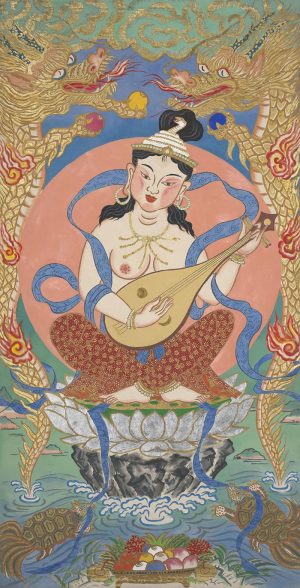
Benzaiten with Two Dragons
Giclee Print - 12” x 20” inches
Sarasvati is a river goddess in India. In Japan, we call her Benten or Benzaiten. This
Benzaiten wears a crown of a white-coiled serpent. As a child, I visited the Zeniarai
Bentenzaiten (money- washing) shrine in the Kamakura Mountains where the waters of a
spring in a small cave are said to be able to multiply the money washed in it. People washed
their purses and wallets in the basket and gave offerings of raw eggs to the white snake that
supposedly lives in the cave.
The two dragons behind her hold the three treasures of Buddhism: Buddha, Dharma, and
Sangha. She plays a Biwa like a Japanese Vina.
Benzaiten was the goddess of art, music, poetry, and learning. As a river goddess, her energy
flows from high to low, like money, so she also became the goddess of commerce and the
protector of merchants to help them conduct ethical business.
-Mayumi Oda
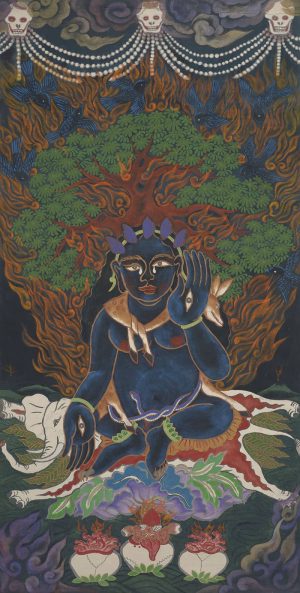
Black Tara
Giclee Print - 12” x 20” inches
"I had never seen an image of Black Tara, so it felt to me that I should paint my Black Tara in
the Mahakala thangka style. Here, the Dharma Protector is a fierce goddess sitting on an
elephant skin in front of a burning tree, surrounded by black birds."
–Mayumi Oda
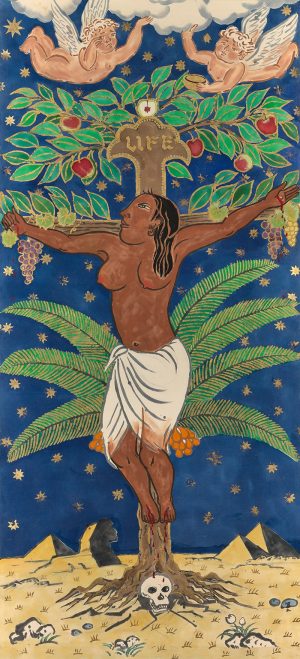
Christa
Giclee Print - 12” x 20” inches
In 1990, at the time of the Persian Gulf War, I painted a large thangka entitled “Christa, Who
Sacrificed the Feminine.” This is what I wrote about it at the time:
“In order to secure the oil in the Middle East, the United States started the Persian Gulf War in
1990 under Bill Clinton. It was during the Gulf War that the military started using war
machines—tanks, guns, and bullets—made of depleted uranium. This is when I realized that
all wars were simply about securing access to power sources.”
I felt this war symbolized the crucifixion of the feminine life force. The words, “Who sacrificed
the feminine?” came to me. The femininity of the Christ had been crucified.
I painted Christa, Christ as a woman, as in the original crucifixion images but hanging from
the Tree of Life whose branches bore the fruits of dates, grapes, and apples.
I feel Christa very much resonates with our political situation now. After so many years, we
are still facing the same problems. Basically, not only was the feminine sacrificed, but also
Jesus Christ in the way he was hanged. A Bodhisattva Savior, his feminine was sacrificed."
–Mayumi Oda
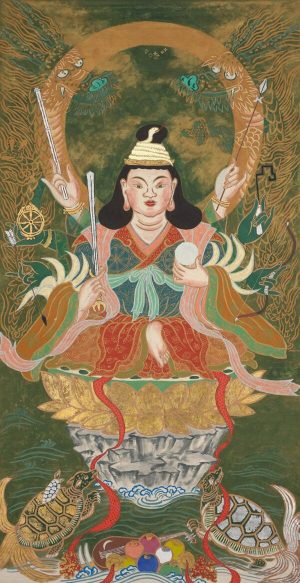
Eight-Armed Sarasvati
Giclee Print - 12” x 20” inches
“In 1999, I received a message from Sarasvati to fight against the nuclear disaster in Japan. I spent five years working as an activist. It was so difficult, and afterward I came back to the studio to paint. I reflected back on that time and painted this eight-armed Sarasvati.”
-Mayumi Oda
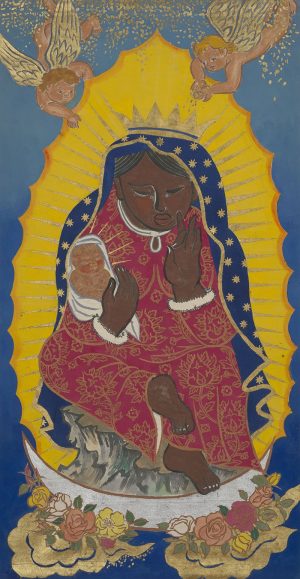
Guadalupe
Giclee Print - 12” x 20” inches
“Our generation, having created nuclear weapons and nuclear power, has left such a sad legacy to this world. So, I made this painting. Madonna as Guadalupe is very sad and tries to protect the children with her star cape. She intercedes for us in time of need.”
--Mayumi Oda
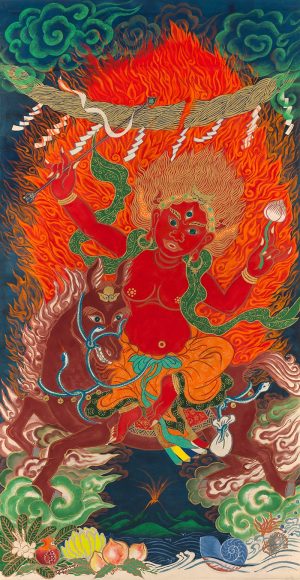
Niutsu Goddess
Giclee Print - 12” x 20” inches
"Niutsu Goddess is a red deity, riding on a red mule and crossing over the river where a
volcano is erupting. A braided straw rope, or shimenawa, traditionally defines a sacred space
or territory of the gods. It is similar to the kapu in Hawai’i. But in this painting the shimenawa
is cut open, like cutting open a secret, hoping that Niutsu would emerge out of it with all her
power to expose her truth. She reminds me of a female Dharma Protector similar to Palden
Lhamo."
–Mayumi Oda
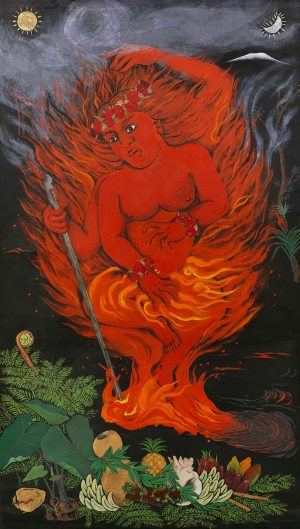
Pele
Giclee Print - 12” x 20” inches
"Pele, Goddess Creation and Destruction, of volcanoes and fire and the creator of the
Hawaiian Islands, appears here as an angry four-armed Dakini. Fitting for this time in the
world, Pele reminds us of the impermanence of life and the importance of focusing on the
Eternal."
–Mayumi Oda
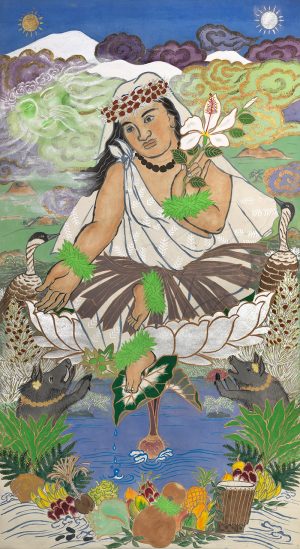
Poliahu
Giclee Print - 12” x 20” inches
"Poli'ahu is the goddess of Mauna Kea, the White Mountain. She and Pele were once rivals,
but water is always stronger than fire. Painted in the style of the Tibetan thangka, Poliahu sits
on a pedestal of Hawaii’s food resource, kalo (taro). On her left side, is her sister, Lilinoi,
Goddess of the Mist.
Poli'ahu sits by Lake Waiau, surrounded by Hawaiian mountain plants, a silversword, and two
nēnē geese. Male and female Kamapua’a (pig gods) offer kukui (light), sweet potatoes, and
the fruit of the land. Hula is the offering of song and dance in Hawai'i."
–Mayumi Oda
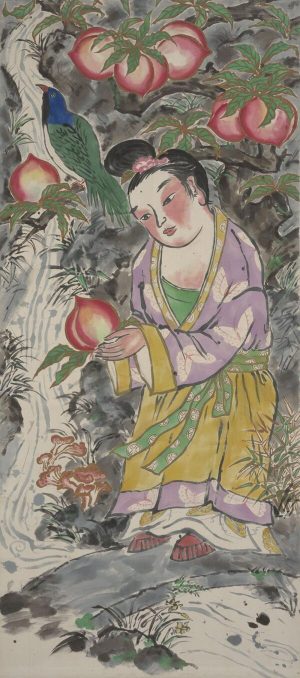
Queen Mother of the West, Seibo
Giclee Print - 12” x 20” inches
“Queen Mother of the West, called Seiobo or Xi Wang Mu, was an ancient Chinese Taoist woman sage of long life who lived on Mount Kunlun. It is said that she grew the immortal peach, which bears fruit only once every 3,000 years. Various emperors tried to steal the sacred fruit. Xi Wang Mu became a tiger to protect the juiciness of life. Here she stands on a bridge offering the pink, juicy peach underneath the immortal phoenix. On the cliff behind her, grow medicinal reishi mushrooms.” -Mayumi Oda
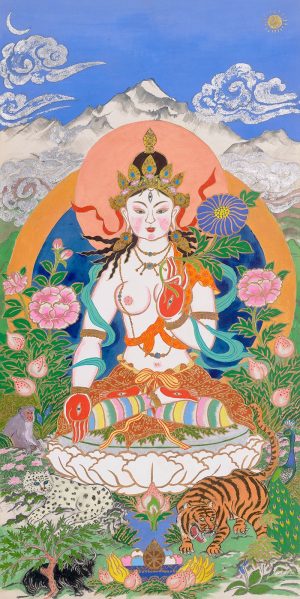
White Tara as Dharma Daughter
Giclee Print - 12” x 20” inches
'Tara is depicted as a sixteen-year-old pure virgin. She has the same role as Avalokiteshvara.
She’s a young woman who already has great mercy for the world.
In this picture, White Tara sits in full lotus with seven eyes to see what’s happening all around
her. The blue flower in the painting is called uḍumbara. According to Buddhist legend, this
flower blossoms every three thousand years. It’s thought that to see a fully awakened person
is so rare, it is like seeing an uḍumbara flower.
This painting is a tribute to Atisha, a prince from Bengal, who brought the teachings of Tara
as Mother to Buddhists in Tibet. Before traveling to Tibet to teach, Atisha was told that his life
would be shortened by twenty years if he made the journey because of the harsh life in the
cold Tibetan plateau. But this did not sway him from making the journey. His sacrifice for the
teachings of Tara made me realize that in order to achieve enlightenment, Buddhists must
sacrifice themselves. Reading the story of Atisha’s life made me want to know more about the
Tara teachings."
–Mayumi Oda
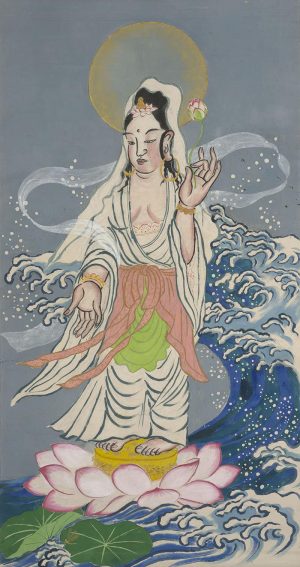
White-Robed Quan Yin
Giclee Print - 12” x 20” inches
"Quan Yin has been our Mother Buddha in Japan, Korea, and China. She is a manifestation
of the Bodhisattva, whose pure white robes represent the purity of mind, which is the aim of
all Buddhist practice. Her light melts our sadness.”
–Mayumi Oda
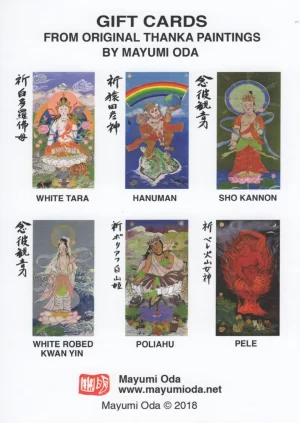
Thanka Greeting Cards – Set of 6
Six of Mayumi Oda's Original Thankas Paintings are now available in 5" x 7" greeting cards. Packet of 6 cards with 6 envelopes. The set includes Poli'ahu, Pele, Hanuman, Sho-Kannon, White-Robed Quan-Yin, and White Tara.



